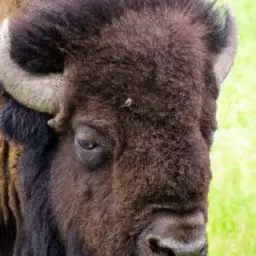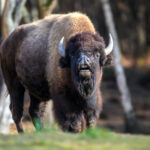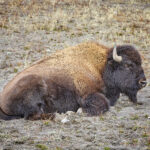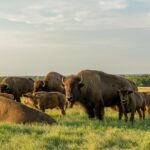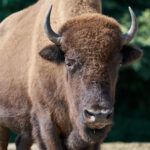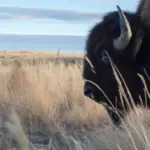Discover the diverse and fascinating world of biomes with the captivating product, “What Biome Does A Bison Live In.” This immersive and educational experience takes you on a journey to understand the unique habitats where bison thrive. From the sprawling grasslands of the prairie to the cold and snowy tundras, you’ll uncover the secrets of these majestic creatures and the biomes they call home. Join us as we explore the wonders of nature, and gain a deeper appreciation for the interconnectedness of life on Earth.
Understanding Biomes
Definition of Biomes
Biomes are large regions of the Earth that are characterized by specific climatic conditions, plant and animal life, and geographical features. They are distinct ecosystems with unique habitats and biodiversity. Biomes are classified based on factors such as temperature, precipitation, soil type, and vegetation cover. There are several major types of biomes found across the world, each with its own set of characteristics and adaptations.
Major Types of Biomes
The major types of biomes include grasslands, forests, deserts, tundra, aquatic, and marine biomes. Grasslands are characterized by vast open areas covered in grasses and a limited number of trees. Forests, on the other hand, are dense areas dominated by trees and are further classified into tropical rainforests, temperate forests, and boreal forests. Deserts are arid regions with minimal rainfall and harsh conditions, while tundra biomes are frozen landscapes located near the Earth’s poles. Aquatic biomes include freshwater and marine ecosystems found in lakes, rivers, oceans, and seas.
Factors that Influence Biome Locations
Several factors influence the distribution and location of biomes. The primary factors include climate, which encompasses temperature and precipitation patterns, and determines the primary vegetation and animal life in an area. Other factors include soil type, topography, altitude, and human activities. These factors interact to create specific conditions necessary for the survival of different species within a biome, including the majestic bison.
Introduction to Bison
Brief Overview of Bison
Bison, also known as buffalo, are large herbivorous mammals native to North America. They are notable for their robust build, impressive horns, and shaggy brown fur. Bison were once a common sight across the Great Plains of North America, where millions of them freely roamed. However, due to overhunting and habitat loss, bison populations drastically declined in the past centuries. Today, efforts are being made to conserve and protect these magnificent creatures.
Types of Bison: Plains and Wood Bison
There are two main types of bison: the Plains bison (Bison bison bison) and the Wood bison (Bison bison athabascae). The Plains bison is the more widespread and abundant type, found predominantly in grassland ecosystems. The Wood bison, on the other hand, inhabits boreal forest regions in Canada and Alaska. While both types share many characteristics, there are subtle differences in their physical traits and habitat preferences.
Physical Characteristics and Adaptations of Bison
Bisons are immense creatures known for their remarkable physical attributes. With a height of up to six feet and a weight of around 2,000 pounds, they are the largest land mammals in North America. Their large hump, located at the front of their shoulder, is a unique feature that distinguishes them from other bovid species. This hump contains large muscles which assist bison in digging through snow during harsh winters to access plant food. Their distinctive horns, which can reach a length of two feet, serve as a formidable defense mechanism against predators.
Bison Habitat
General Description of Bison Habitats
Bison habitats vary depending on their type and prevailing environmental conditions. Plains bison primarily inhabit grasslands, which are expansive areas characterized by fertile soil and a relatively dry climate. These grasslands provide an essential food source for bison, consisting of grasses, herbs, and shrubs. Wood bison, on the other hand, occupy boreal forests, which are vast coniferous forests dominated by spruce, pine, and birch trees. These forests provide wood bison with an abundance of vegetation, including woody plants, mosses, and lichens.
Factors Determining Bison Habitat Preferences
Several factors influence the habitat preferences of bison. Key factors include food availability, water sources, suitable shelter, and the presence of predators. Grasslands provide ample grazing opportunities for Plains bison, while boreal forests offer diverse food sources and protection from harsh weather conditions for Wood bison. Water availability is crucial for both types of bison, as they require frequent access to drinking water. Additionally, the presence of open areas and sufficient space for roaming is essential for their survival.
Bison’s Biome: Grasslands
Overview of Grasslands Biome
The grasslands biome is one of the major ecosystems on Earth, covering vast areas across different continents. It is characterized by a dominant vegetation of grasses, as well as flowering plants and low-lying shrubs. Grasslands are often found in areas where rainfall is insufficient to support the growth of forests but too abundant for desert formation. The grasslands biome provides a unique and vital habitat for a variety of organisms, including the iconic bison.
Features of Grasslands Favorable to Bison
Grasslands offer several features that make them favorable habitats for bison. The primary feature is the abundance of grass, which serves as their main food source. The openness of the grasslands allows bison to easily graze and spot potential predators from a distance. The flat terrain also favors bison in terms of locomotion and movement, as they can cover large distances in search of food. The moderate climate in grasslands, characterized by warm summers and cold winters, suits the bison’s adaptation to changing seasons.
Bison’s Role in Grasslands Ecosystems
Bison play a crucial role in maintaining the balance and health of grasslands ecosystems. Their feeding habits help control the growth of grasses and promote species diversity. By grazing on some plants and trampling others, bison create a mosaic of grassland habitats, which benefits other herbivores and allows for the growth of different plant species. Their droppings also serve as natural fertilizers, enriching the soil and aiding in the regeneration of vegetation. Furthermore, the bison’s large size and mobility can help disperse seeds, contributing to the spread of plant life in grasslands.
Bison’s Biome: Boreal Forests
Description of Boreal Forest Biome
Boreal forests, also known as taiga, are extensive forests found in the high latitudes of the Northern Hemisphere. They are characterized by a mix of coniferous trees such as spruce, pine, and fir, as well as deciduous trees like birch and aspen. Boreal forests experience long and cold winters, short summers, and moderate precipitation. These forests provide a unique environment for various species, including the Wood bison.
How Bisons Adapt to Boreal Forests
Wood bison, as the name suggests, are well-adapted to thrive in boreal forest environments. Their large size and thick fur provide insulation during the cold winters. The bison’s broad and flat hooves allow them to traverse the snowy terrain with ease. They are highly efficient at foraging through deep snow, using their massive heads and strong neck muscles to clear paths. Wood bison have also developed a specialized digestive system that enables them to digest the fiber-rich diet of woody plants and lichens found in boreal forests.
Impact of Bison on Boreal Forest Ecosystems
Bison have a significant impact on the biodiversity and dynamics of boreal forest ecosystems. Their grazing and browsing activities help shape the vegetation communities by promoting the growth of certain plant species and limiting the dominance of others. By selectively consuming specific plants, bison create openings in the forest canopy, which allows sunlight to reach the forest floor and stimulates the growth of understory vegetation. Their physical presence also influences other species, as bison wallows and trampled areas create unique microhabitats that attract different insect, bird, and small mammal populations.
Bison Migration
Understanding Bison Migration Patterns
Bison are known for their migratory behavior, which involves seasonal movement between different areas. They undertake long-distance journeys in search of food, water, suitable breeding grounds, and areas with milder climates. Bison migration patterns are essential for survival and have been shaped by evolutionary and ecological factors over thousands of years.
Factors Influencing Bison Migration
Several factors influence bison migration, including food availability, water scarcity, climate conditions, and predator avoidance. As herbivores, bison migrate to areas with abundant grass and forage during the summer months. They also migrate in response to changes in water availability, as they require reliable water sources for drinking and to support their diet. Climate, specifically harsh winters or extreme heat, can trigger migration as bison seek more favorable weather conditions. Additionally, the avoidance of predators such as wolves and bears may also influence migration patterns.
Impact of Migration on Bison Biome Locations
The migration of bison plays a crucial role in shaping their biome locations. By moving between different areas, bison can access a greater range of resources and adapt to changing environmental conditions. This movement also helps disperse seeds and nutrients, contributing to the overall health and diversity of their habitats. However, human interference and habitat fragmentation have disrupted traditional migration routes for bison, posing challenges to their survival and the maintenance of their biome locations.
Impact of Humans on Bison Habitats
Historical Relationship between Humans and Bison
Humans have had a profound impact on bison habitats throughout history. Native American tribes, such as the Plains Indians, relied on bison for sustenance, using their meat, hides, and bones for various purposes. These tribes practiced sustainable hunting techniques, ensuring the bison population remained stable. However, with the arrival of European settlers in North America, the bison faced catastrophic declines due to overhunting, habitat destruction, and the loss of their traditional grazing lands.
Effects of Human Activities on Bison Habitats
Human activities, including agriculture, urbanization, and the construction of infrastructure, have significantly impacted bison habitats. The conversion of grasslands into farmland and the fragmentation of forests for development have led to the loss and degradation of essential bison habitats. Additionally, the fencing of land and barriers such as roads and highways disrupt their migration patterns and limit their access to food and water sources. These human-induced changes pose a threat to the survival of bison populations and the maintenance of their biomes.
Conservation Efforts for Bison Habitats
Recognizing the importance of bison and their habitats, various conservation organizations, government agencies, and indigenous communities have taken steps to protect and restore bison habitats. Efforts include the establishment of protected areas, such as national parks and reserves, where bison thrive under regulated conditions. Habitat restoration projects aim to reconnect fragmented landscapes and create corridors for migration. Additionally, education and awareness programs promote responsible land management practices to mitigate the negative impacts of human activities on bison habitats.
Bison Behavior in Different Biomes
Bison Behavior in Grasslands
In grassland biomes, bison exhibit unique behavioral characteristics that allow them to thrive in this environment. They graze extensively, consuming large amounts of grass and other vegetation throughout the day. Bison form social groups called herds, in which they display a hierarchical structure led by dominant males, known as bulls. During mating season, bulls engage in fierce battles for mating rights with receptive females. Herd cohesion is crucial for protection against predators, and bison communicate through various vocalizations, body postures, and scent marking.
Bison Behavior in Boreal Forests
In boreal forest biomes, bison behavior is influenced by the dense vegetation and rugged terrain. Wood bison form smaller groups compared to Plains bison, typically consisting of females and their offspring. Male wood bison often occupy larger solitary ranges during the non-breeding season. Due to the limited visibility in the forest, bison rely heavily on their sense of smell and hearing to detect predators. They use well-worn trails, known as “caribou trails,” to navigate through dense vegetation. During the mating season, male wood bison engage in fierce competition, using their size and strength to assert dominance.
Factors Affecting Bison Behavior in Various Biomes
Various factors influence the behavior of bison across different biomes. Food availability is crucial, as bison allocate a significant amount of time to feeding. The size and makeup of social groups are influenced by the resources present in a particular biome. Predation risk also affects behavior, with bison becoming more vigilant and defensive in areas with higher predator densities. Environmental conditions, such as temperature and weather patterns, can impact bison behavior, influencing their movements, mating rituals, and foraging strategies. The interplay between these factors shapes the behavioral patterns of bison in their respective biomes.
Bison and Climate Change
Effects of Climate Change on Bison Habitats
Climate change poses significant challenges to bison habitats and their ability to adapt. Rising global temperatures can alter precipitation patterns, resulting in droughts and the degradation of grasslands. Reduced water availability affects bison’s access to drinking sources and impacts the growth of vegetation. Heat stress also poses a threat, as bison are adapted to cooler climates. Additionally, changes in weather patterns influence the phenology of plants, affecting the timing of food availability and potentially disrupting the synchronization between bison migration and the optimal grazing periods.
Bison’s Adaptation to Changing Climates
Bison have evolved to withstand a range of environmental conditions and are known for their adaptability. They possess physiological mechanisms that help them regulate body temperature during hot weather, such as sweating and seeking shade. In colder climates, their thick fur and insulating fat reserves aid in preventing heat loss. Behavioral adaptations, such as changes in migration patterns or foraging strategies, enable bison to cope with shifting climates. However, the rate and magnitude of climate change may surpass their ability to adapt, placing their survival and the integrity of their biomes at risk.
Potential Impact of Climate Change on Bison’s Biome Preferences
Climate change may lead to alterations in the geographical distribution of biomes, influencing the availability of suitable habitats for bison. Shifts in temperature and precipitation patterns can affect the extent and productivity of grasslands, potentially reducing the available grazing areas for Plains bison. In boreal forests, changes in snowfall patterns and temperature may alter the availability and accessibility of food sources for Wood bison. These changes may force bison to migrate to new areas, impacting the ecological dynamics of both their current and potential future biomes.
How did the biome affect the evolution of the bison?
The biome played a crucial role in shaping the factors in bison evolution. The harsh environmental conditions forced bison to adapt by developing larger bodies and thick fur to withstand cold temperatures. Additionally, the availability of specific plants and grasses influenced their diet, leading to further evolutionary changes in their digestive system.
Future of Bison in their Biomes
Current Status of Bison Populations
Bison populations have experienced significant decline over the past centuries due to human activities and habitat loss. However, conservation efforts have successfully revived some populations. Today, Plains bison populations have rebounded, primarily due to conservation programs and managed herds in protected areas. Wood bison populations, while still vulnerable, have shown signs of recovery through targeted conservation measures. Nevertheless, the overall conservation status of bison remains a concern, requiring ongoing efforts to secure their future and the preservation of their biomes.
Predicted Changes in Bison Habitats
It is expected that bison habitats will continue to be influenced by various factors, such as climate change, land development, and human activities. Changes in climate may result in shifts in the distribution and composition of grasslands, potentially limiting the availability of suitable grazing areas for Plains bison. Boreal forests may also undergo modifications in response to climate change, impacting the behavior and habitat preferences of Wood bison. Human encroachment and habitat fragmentation further exacerbate the challenges faced by bison, highlighting the need for proactive conservation strategies.
Strategies for Bison Conservation in Different Biomes
Conserving bison in their respective biomes requires a multi-faceted approach. Protecting and restoring critical habitats, such as grasslands and boreal forests, is essential for maintaining viable populations. Habitat management practices, such as controlled grazing and prescribed burning, can simulate the natural processes that maintain ecosystem health. Collaboration with indigenous communities, who hold traditional knowledge and a deep understanding of bison, is crucial for effective conservation efforts. Additionally, raising awareness and engaging the public in supporting bison conservation can foster a broader sense of responsibility and ensure a sustainable future for these iconic creatures and their biomes.
In conclusion, understanding the relationship between bison and their biomes is crucial for their conservation and the preservation of these diverse ecosystems. Biomes, such as grasslands and boreal forests, provide unique habitats that support the survival and well-being of bison. However, human activities, climate change, and habitat loss pose significant challenges to their long-term existence. By implementing conservation strategies, protecting critical habitats, and promoting awareness, we can ensure a future where bison continue to thrive in their biomes, contributing to the health and biodiversity of our planet.

